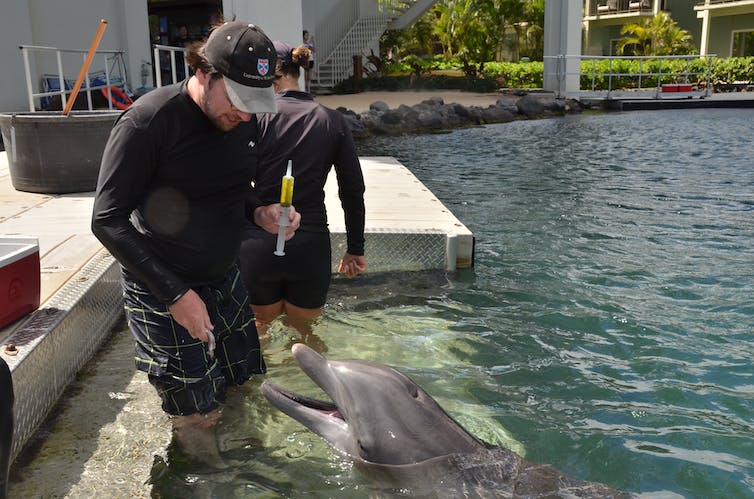Bottlenose dolphins’ signature whistles just passed an important test in animal psychology. A new study by my colleagues and me has shown that these animals may use their whistles as namelike concepts.
By presenting urine and the sounds of signature whistles to dolphins, my colleagues Vincent Janik, Sam Walmsey and I recently showed that these whistles act as representations of the individuals who own them, similar to human names. For behavioral biologists like us, this is an incredibly exciting result. It is the first time this type of representational naming has been found in any other animal aside from humans.
The meaning of a name
When you hear your friend’s name, you probably picture their face. Likewise, when you smell a friend’s perfume, that can also elicit an image of the friend. This is because humans build mental pictures of each other using more than just one sense. All of the different information from your senses that is associated with a person converges to form a mental representation of that individual – a name with a face, a smell and many other sensory characteristics.
Within the first few months of life, dolphins invent their own specific identity calls – called signature whistles. Dolphins often announce their location to or greet other individuals in a pod by sending out their own signature whistles. But researchers have not known if, when a dolphin hears the signature whistle of a dolphin they are familiar with, they actively picture the calling individual. My colleagues and I were interested in determining if dolphin calls are representational in the same way human names invoke many thoughts of an individual.
Dolphins use signature whistles to identify themselves.
Jason Bruck, CC BY-ND31,5 ko (download)
Because dolphins cannot smell, they rely principally on signature whistles to identify each other in the ocean. Dolphins can also copy another dolphin’s whistles as a way to address each other.
My previous research showed that dolphins have great memory for each other’s whistles, but scientists argued that a dolphin might hear a whistle, know it sounds familiar, but not remember who the whistle belongs to. My colleagues and I wanted to determine if dolphins could associate signature whistles with the specific owner of that whistle. This would address whether or not dolphins remember and hold representations of other dolphins in their minds.

The researchers found that dolphins can identify each other by swimming through and tasting urine, the liquid in the syringe in this photo.
Dolphin Quest, CC BY-ND
Urine as an identifier
The first thing my colleagues and I needed to do was find another sense that dolphins use to identify each other. In the 1980s and 1990s, researchers studying spinner dolphins in Hawaii noticed that the dolphins were occasionally swimming through each other’s urine and feces with their mouths open. Using…



